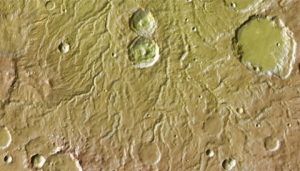Mars was once far wetter than it is now — but just how wet?

R. A. Craddock & R. D. Lorenz / Icarus 2017
Once upon a time (about 3.7 billion years ago, to be exact), there was rain on Mars. In fact there was enough liquid water on the Red Planet to create vast valley networks and overflowing crater lakes. But these conditions didn’t last long. The poor planet lost its atmosphere and became a frozen wasteland.
Based on geologic evidence, scientists are confident rain fell on ancient Mars. But how much rain? In the September 1st issue of Icarus, Robert Craddock (Smithsonian Institution) and Ralph Lorenz (Johns Hopkins University Applied Physics Laboratory) take a fun foray into the past, exploring how Martian rainfall might have changed with time and how much of an impact the rain could have had on the surface.
Two forces act on a raindrop: gravity (down) and air drag (up). A thicker atmosphere produces more drag, which means raindrops will fall more slowly. Denser atmospheres also produce smaller raindrops. That’s because as falling drops become larger, aerodynamic drag flattens their bottoms, until the drop “assumes a shape similar to the top of a hamburger bun,” Craddock and Lorenz write. Boost the drop size more, and it’ll deform into an umbrella shape, until the drag force fragments it.
With some assumptions thrown into the mix, the team explored how intense ancient Martian rain could have been. The duo calculated max drop size, terminal velocity, and rainfall intensity across a range of atmospheric pressures from 0.5 to 10 bars, where 1 bar is the air pressure at Earth’s sea level. This range encompasses a variety of proposed conditions for early Mars.
Depending on how well Martian soil would soak up rain (or not), Craddock and Lorenz suggest that in atmospheric pressures greater than 4 bars, precipitation would have had the intensity of fog — too gentle to erode the landscape. But as Mars lost its atmosphere over the millennia, raindrops could have grown larger and fallen harder, reaching drizzle levels. Conditions would have hit the sweet spot at 1.5 bars, with intensity levels on par with terrestrial storms — although, the combination of larger drops and slower terminal velocities on Mars compared with Earth would mean that a storm on the Red Planet would be only 70% as intense as its terrestrial twin, the authors note. (If you’re curious, the maximum drop size would be around 7½ mm, 1 mm bigger than on Earth.)
Rain’s intensity would have continued to rise until 0.5 bar, when the atmosphere should have collapsed.
The calculations suggest that there would have been a brief window in Martian history when rain could have spurred serious erosion. This inference makes sense: The planet’s deep valley networks formed around 3.7 billion years ago, which is around the time the atmosphere was peacing out. A 2012 study by Timothy Goudge (then of Brown University) and others also found only limited signs of water-related mineral transformations in more than 200 Martian lake basins, suggesting that the lakes didn’t last long.
Craddock and Lorenz go on to argue that their prediction of how rain’s intensity changed with time matches the change in crater erosion patterns between the Noachian (4.1 to 3.7 billion years ago) and Hesperian (3.7 to 3.3 billion) periods on Mars, with less erosion during the Noachian and more during the Hesperian. But a lot of other processes have eroded craters on Mars, notably volcanism: The 2012 Goudge study found that volcanism had resurfaced more than 40% of the lake basins investigated, and volcanism was especially active in the Hesperian period.
Still, while we should take the connection to erosion with a grain of salt (or perhaps a drop of salty water), the rainfall study is a delightful romp through Mars’s potential past.
References:
Robert A. Craddock and Ralph D. Lorenz. “The Changing Nature of Rainfall During the Early History of Mars.” Icarus. September 1, 2017.
Timothy A. Goudge et al. “An Analysis of Open-Basin Lake Deposits on Mars: Evidence for the Nature of Associated Lacustrine Deposits and Post-Lacustrine Modification Processes.” Icarus. May 2012.
Explore the Red Planet with your own eyes with Sky & Telescope's Mars globes.
 0
0









Comments
You must be logged in to post a comment.